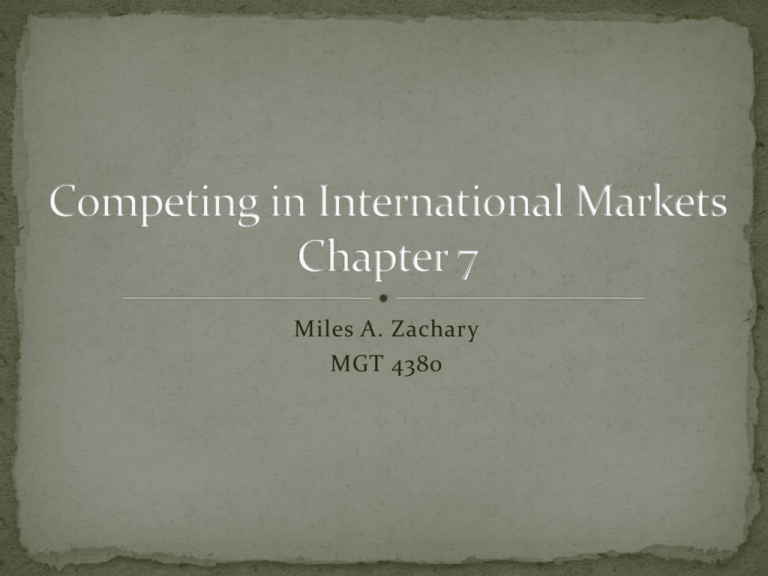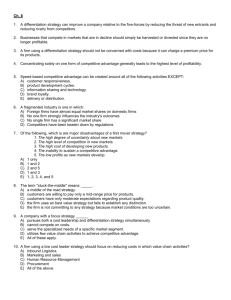Selecting Corporate-Level Strategy Chapter 8
advertisement

Miles A. Zachary MGT 4380 The rise of international business has followed globalization and the development of BRIC economies Good or Bad? Good Access to new customers Lower costs—access to cheaper raw goods and labor Diversification of business risk Bad Political risk Economic risk Cultural risk Moving into an international market provides access to new customers US population accounts for only 5% of global consumers What are some new emerging markets into which US businesses could enter? Different cost advantages can be gained by internationally-diverse firms Increasing volume lowers production costs (economies of scale) Access to cheaper labor/raw goods Offshoring: relocating a business activity to another country Despite these advantages, some firms are finding that offshoring is not appropriate for their business Led to reshoring—jobs and businesses return to their home country Business risk is the potential that business operations might fail Firms located in a single country are open to “monodirectional” business risk—either up or down However, international firms operate in a variety of markets and therefore less susceptible to monodirectional business risk Similar to the idea of diversifiable or unsystematic risk Political risk-the potential for government upheaval or interference with business to harm an operation within a country Difficult to plan business operations Possibility of excessive hostility toward foreign businesses In rare but extreme cases, a countries government could nationalize an industry or industries, eliminating foreign control Underdeveloped countries tend to have the highest political risk(s) Economic risk-the potential for a country’s economic conditions and policies, property rights, protections, and currency exchange rates to harm business operations Dynamic economic conditions make it difficult to know how to anticipate economic risks Cultural risk-the potential for a company’s operations in a country to struggle because of differences in language, customs, norms, and customer preferences Businesses should research local customs and be prepared to adapt business operations In some ways, globalization has decreased the advantages gained and disadvantages lost to operating in one country over another In others, research has suggested that business still derive advantages and disadvantages from locating in specific countries Michael Porter at HBS developed the Diamond Model of National Advantage (1990) to help determine the potential for firm success in a given international environment The model helps determine a firm’s ability to compete in a particular country Four dimensions: Home demand conditions 2. Home factor conditions 3. Home related and supporting industries 4. Firm strategy, structure, and domestic rivalry 1. Home demand conditions refer to the local demand characteristics and nature of domestic customers Local customers with high standards help prepare firms for competing on a global scale E.g., Toyota and Japanese consumers Home factor conditions refers to the nature of raw materials and other inputs needed to create goods and services Includes land, labor, capital, and entrepreneurial ability While some countries have their advantages, overcoming disadvantages can have its benefits E.g., Japan develops the JIT inventory system due to space shortages Home related and supporting industries refers to the extent to which a firm’s domestic suppliers and other complementary industries are developed and helpful How does the value chain support our business? E.g., US cattle industry is supported well by incredible productive capabilities of US farmers Firm strategy, structure, and domestic rivalry determines how challenging it is to survive domestic competition Companies that survive intense competition among domestic competitors are better equipped to handle foreign competitors E.g., Toyota had to contend with other Japanese auto firms A multinational corporation (MNC) is a firm that has operations in more than one country Such firms must choose how to structure their international strategy Three (3) main strategies Multidomestic Global Transnational Focuses on responsiveness to local requirements while sacrificing efficiency Many times firms must adapt their products to fit in a variety of domestic markets Coca-cola has dozens of brands with distinct flavors in different countries A global strategy sacrifices responsiveness to local requirements in favor of efficiency It is the opposite of the multidomestic strategy While some minor modifications may occur, the products and services remain generally unaltered for foreign markets E.g., Microsoft products are only adapted to meet local language needs, but are otherwise homogenous Firms following a transnational strategy try to balance the desire for efficiency with the need to adjust to local preferences In between a multidomestic strategy and global strategy E.g., KFC and McDonald’s keep a core menu while making some concessions in local markets such as poutine in McDonald’s in Canada Once an firm decides to enter a foreign market, it must then determine how to do so Five (5) basic entry options Exporting Wholly-owned subsidiary Franchising Licensing Joint venture or strategic alliance These options vary in the amount of control a business has on operations, how much risk is involved, and what share of the foreign operation’s profits a firm gets to keep Exporting refers to creating goods within a firm’s home country and then shipping them to another country where they are sold to customers by a local firm Typically seen as a starting point for most firms starting international operations A lower-cost way to determine foreign preferences and demand for a firm’s products After the products become desirable in a foreign market, exporting becomes a unattractive Firms loose control of goods once they enter a foreign market—potentially allowing local merchants to hurt the brand A wholly owned subsidiary is a business operation in a foreign country that a firm fully owns Can occur in two (2) ways: Greenfield venture in which the firm creates the entire operation itself Acquiring a foreign operator Attractive because the firm maintains complete control over the operation and keeps all the profits Can be risky since a firm must pay all the expenses to setup and operate the business Franchising is when an organization (franchisor) grants the right to use its brand name, products, and processes to another organization (franchisee) Usually occurs in exchange for up-front payment (franchise fee) and a percentage of revenues (royalty fee) Attractive because it requires little investment But, franchisors enjoy only some of the profits, must monitor franchisees for undesirable behavior, and must provide a clear and effective business model In licensing, one organization grants another organization the right to create its products, often using patented technology, in exchange for a fee Most frequently used in manufacturing industries Attractive because granting firms deflect costs, but lose control over how technology is used and limits their profitability Foreign joint ventures and strategic alliances occur when a firm believes it to be beneficial to work with one or more local partners In a joint venture, two or more organization contribute to a new organization In a strategic alliance, two or more organizations work together without establishing a new organization Attractive because local organizations can supply valuable local knowledge and facilitate local acceptance Can be difficult to manage when firms have trouble getting along









